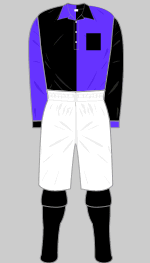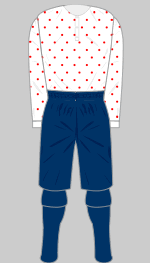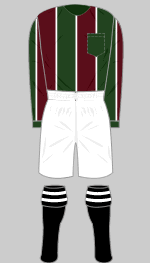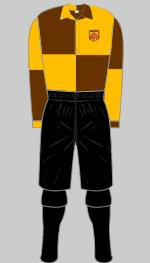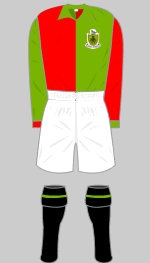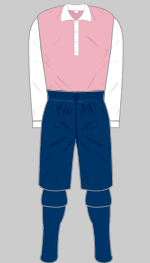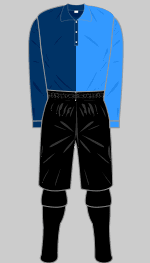Strange Hues - Exotic Early Football Kits
During the Victorian and Edwardian eras in particular, many clubs wore colour combinations that would be considered extraordinary today. Here are my favourites. Click on the names of each club to access the full archive. Use the Back Button in your browser to return to this page.
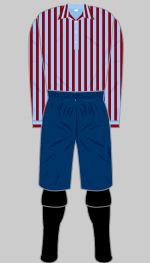 |
Arsenal wore plain red shirts until the great Herbert Chapman introduced white sleeves in 1934. However, for one season only, the club, then known as Woolwich Arsenal wore red and light blue striped shirts. |
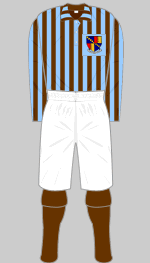 |
Villa have been associated with classic claret shirts with light blue sleeves since the late nineteenth century but in their early days, they wore all sorts of colours including this striped combination. |
|
Barnet's early history is complex and the club did not join the Football League until 1991. This violet and black kit was worn by the original Barnet FC, which was wound up in 1901.
|
|
The club was renamed as Barnsley in 1897 and a year later was elected to the Football League. Prior to this Barnsley had worn this chocolate white striped shirt with intriguing horizontally striped sleeves. |
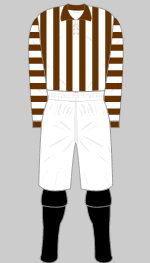 |
Ever since the 1930s, Blackpool have been associated with tangerine but prior to this, the Seasiders wore a bewildering array of kits including this outfit, a gesture of support to Belgian refugees of the Great War. |
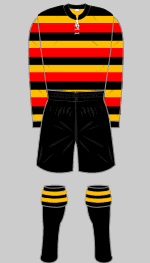 |
This extraordinary kit was documented in contemporary newspapers although no photographs appear to exist. The design would be more familiar on the racecourse than in a football ground. |
|
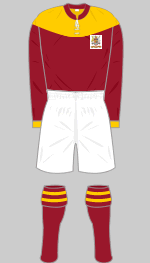 |
City's combination of claret and amber is unique in the Football League and has been worn to this day. This elegant yoked design was worn when City won the FA Cup.
|
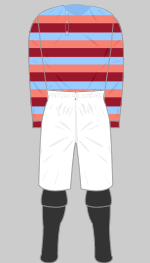 |
Brentford FC was formed by members of the local rowing club. These claret, salmon pink and light blue shirts were worn in their first season and inherited from the parent club.
|
|
Colchester Town were formed in 1873 but came to grief in 1937. This wonderful strip in myrtle green, dark claret and white was worn in 1913. Colchester united were formed from the Oystermen's ashes.
|
|
Known as Black Arabs at the time, the club name suits this odd strip. This was revived as a change kit around 2003.
|
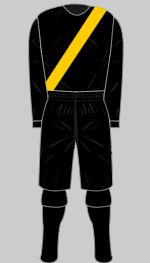 |
Long before Burnley settled on their more familiar claret and blue, they wore a number of combinations including this spectacular pink and white striped shirt from the Victorian period.
|
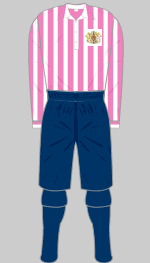 |
At one time the brewing town of Burton boasted two clubs in the League. The Swifts played in all manner of colours including this orange and maroon outfit.
|
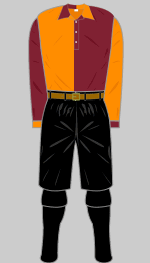 |
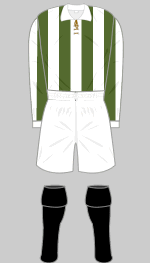 |
Chester have worn various colours throughout their history including this dark green and white kit, which gave rise to the nickname "The Hollies."
|
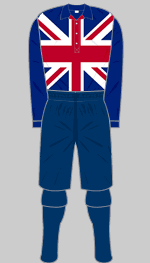 |
This uniquely patriotic design was worn for a single season before plain white shirts were adopted. We know now these were found in the loft of the Spital Arms and donated to the club. |
|
Formed as Riverside FC, the club wore chocolate and amber until 1908 when they became Cardiff City and adopted the more familiar blue and white.
|
|
Singers FC played in the company colours of their parent bicycle company and became known as the "Little Blackbirds." In 1898 they became Coventry City.
|
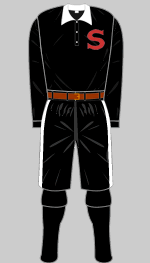 |
In 1922 Coventry briefly abandoned their light blue and white colours in favour of the light green and red municipal colours of the city.
|
|
Formed as an offshoot of Derbyshire CC, County initially wore the chocolate, amber and blue of the cricket club.
|
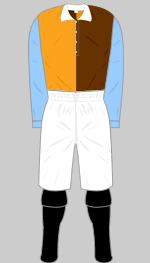 |
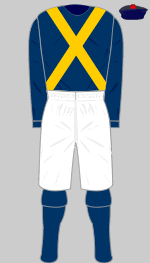 |
This early Rovers strip is more typical of horse racing colours than football kits.
|
|
Recent research has revealed several hitherto unrecorded kits including this attractive pink and white outfit, Everton did not adopt their now traditional royal blue and white until 1901.
|
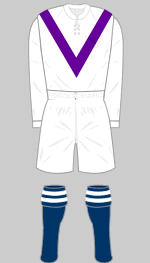 |
Glossop played in the League between 1898 and 1915. An unusual feature of this kit worn towards the end of their League career is the purple trimmed shirt.
|
|
This striking kit was described as cardinal red and blue.
|
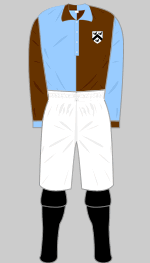 |
This dark blue and old gold combination predates the fashion for pinstriped shirts by almost 50 years.
|
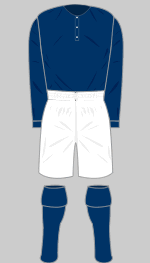 |
Orient have worn some eye-catching kits through the years but none more striking than this striped combination, worn during their first season in the League.
|
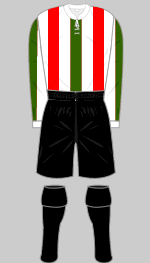 |
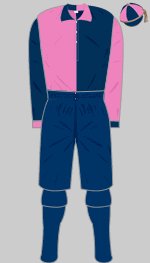 |
Described as navy blue and pink, this kit is from Luton's pre-Football League days and was worn with matching caps.
|
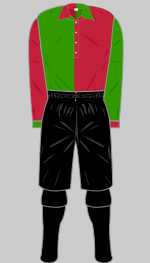 |
<< Middlesbrough Ironopolis 1889 Formed as rivals to Middlesbrough FC, The "Nops" wore maroon and light green in their first ever season.
|
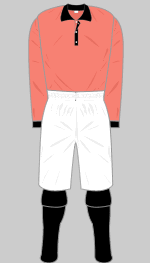 |
Formed as a commercial venture, Tower lasted only three seasons in the League before resigning in 1901.
|
|
In 1938 Newport ordered a set of amber shirts with black hoops. A misunderstanding meant they started the season wearing black shirts before the correct versions were delivered.
|
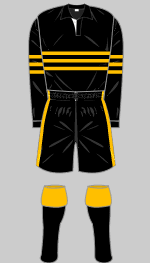 |
The Cobblers have worn the municipal colours of claret and white since 1899, for the first two seasons of their existence they turned out in chocolate and blue.
|
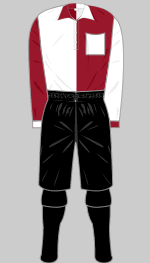 |
Chocolate and light blue was not uncommon in Victorian times. Notts County wore these colours in the 1880s and revived them very briefly in 1934.
|
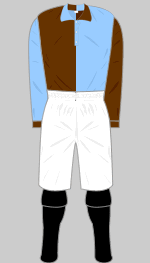 |
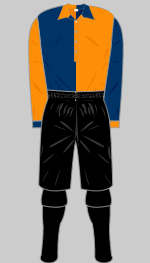 |
Although Oxford did not join the League until 1962, the club was formed as Headington United in the last decade of the nineteenth century when they wore orange and navy blue.
|
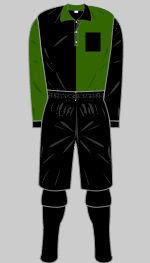 |
Plymouth's green and black colours have been attributed to the tartan of the Argyle & Sutherland Highlanders, once stationed in the town in the late nineteenth century but are more likely the municipal colours |
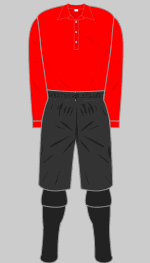 |
When Burslem Port Vale took their place in The Football League their first registered colours included "grey serge knickers."
|
|
Portsmouth's first colours were pink with maroon trim.
|
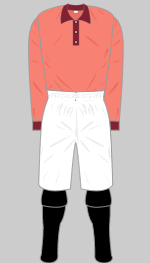 |
Before they became founders members of the Football League, Stoke (as they were then called) wore light blue and black.
|
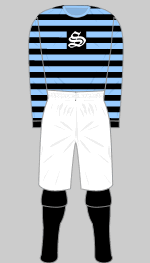 |
In the 1895-96 season, Rovers registered their colours as green and buff.
|
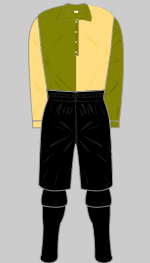 |
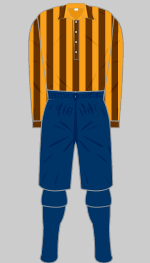 |
Spurs adopted these chocolate and amber shirts when they joined the Southern League in 1896. Their famous white shirts appeared two years later. |
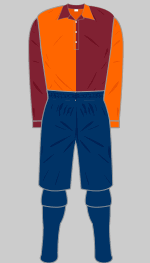 |
Rovers are associated with sober blue and white kits but at the turn of the nineteenth century they played in this dramatic orange and maroon kit. |
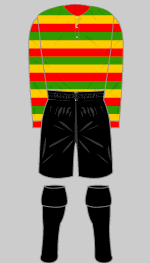 |
Watford wore a number of exotic kits in their early years including this colourful hooped design from the early 20th century.
|
|
In the early 1930s, Watford registered their colours as turquoise shirts, certainly unique in English football.
|
|
Albion wore all sorts of interesting combinations during their early career, including this attractive yellow and white quartered shirt.
|
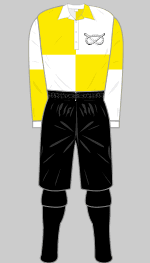 |
In their second season as members of the League, Albion wore broad scarlet and blue stripes with a stripe sewn into their britches.
|
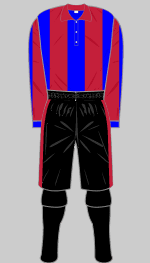 |
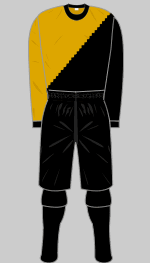 |
<< Wolverhampton Wanderers 1892 Wolves started out in pink and white stripes but in 1892 they wore this dramatic diagonally halved shirt in their now traditional old gold and black, unique in Football league history.
|
|
The North Wales side have worn various colours during their long history. This kit dates from the end of the nineteenth century.
|
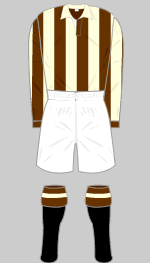 |
The manufacture of chocolate is one of the principle industries in York. So what could be more natural than to play in chocolate and cream shirts?
|
|
Hull are the only club to have registered an all-black kit with the Football League.
|
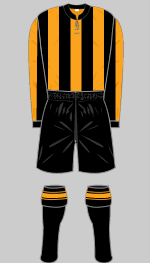 |
The Terriers are associated with blue and white stripes but when they joined the League, they played in this attractive white kit with a blue yolk.
|
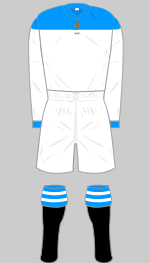 |
When Stoke were re-admitted to the League in 1891, regulations did not allow two clubs to register the same kit and Sunderland were in red and white stripes. Stoke continued to play in red and white in non-League competition. |
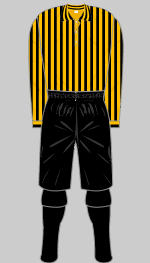 |
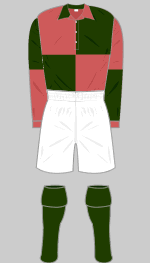 |
Burton Swifts and Burton Wanderers amalgamated in 1901 but the new club survived only until 1905. Between them, the clubs played in every imaginable colour including green with "Indian Red" trim. |
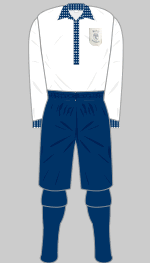 |
Long before 'Boro turned professional and joined the Fotball League, they played in white shirts set off by rather fetching white polka dots.
|
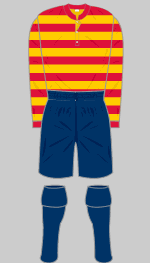 |
Once upon a time the modest market town of Ayr boasted two clubs in the Scottish Football League. Ayr FC wore this spectacular crimson and gold kit before merging with Ayr Parkhouse in 1910 to form Ayr United.
|
|
Orion were one of three clubs that would merge to form the modern Aberdeen FC. Their remarkable shirts were described as "Bismarck." Well it does sound a lot better than "brown." |
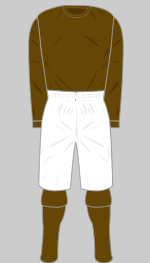 |
The Buddies established their traditional black and white stripes in the nineteenth century but spent several seasons playing in these splendid cream jerseys. |
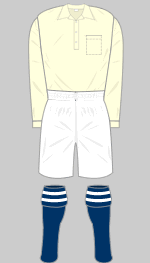 |
The school colours of Hamilton Academy were blue and white but Hamilton FC already played in these so the Accies chose red and white instead. For one season these became cerise and French grey.
|
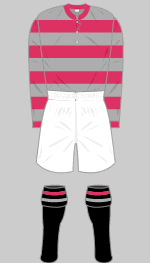 |
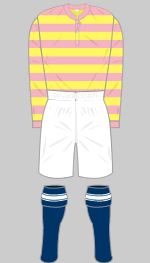
|
The Saints were regarded as Edinburgh's third club for many years. At the turn of the 19th century they adopted the primrose and pink racing colours of local football patron Lord Rosebery. The national side also played in these colours on several occasions in the late 19th and early 20th centuries. |
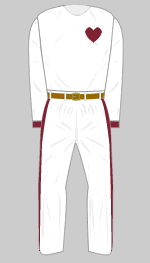 |
This is among the earliest recorded kits to have been verified from photographs. "And, oh my word...they're wearing trousers!!" |
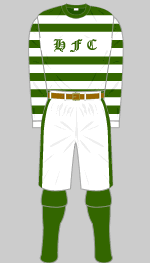 |
Hibs were formed as a charitable institution to provide relief for impoverished Irish emigres and their success inspired the formation a multitude of similar clubs throughout Scotland. In 1876 they wore these striking hooped jerseys 12 years before Celtic were formed. |
